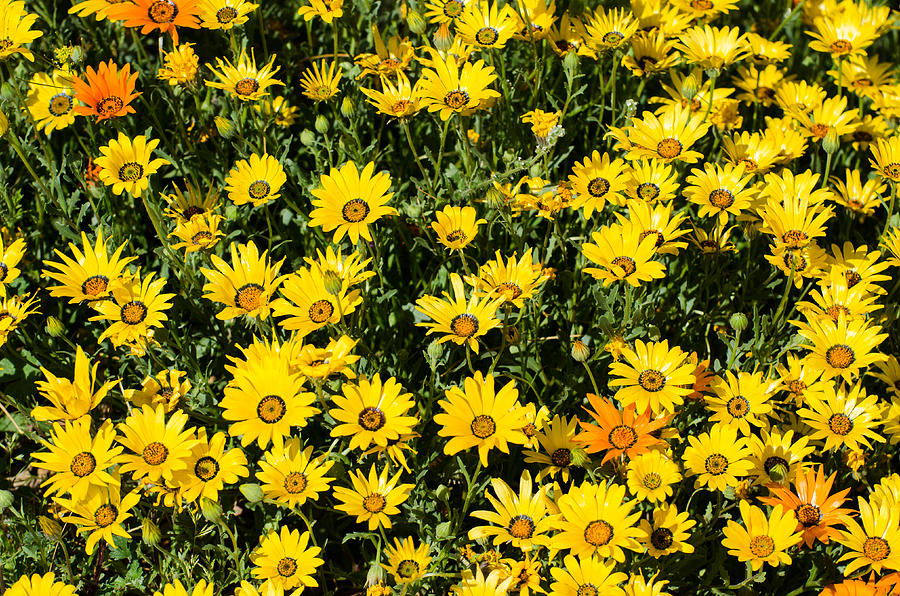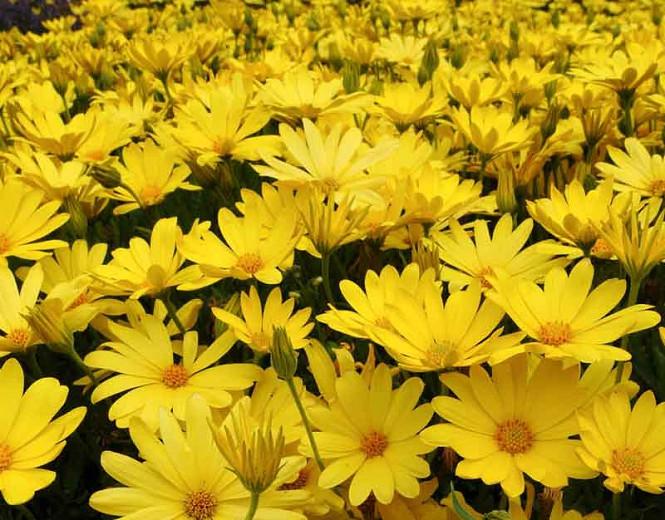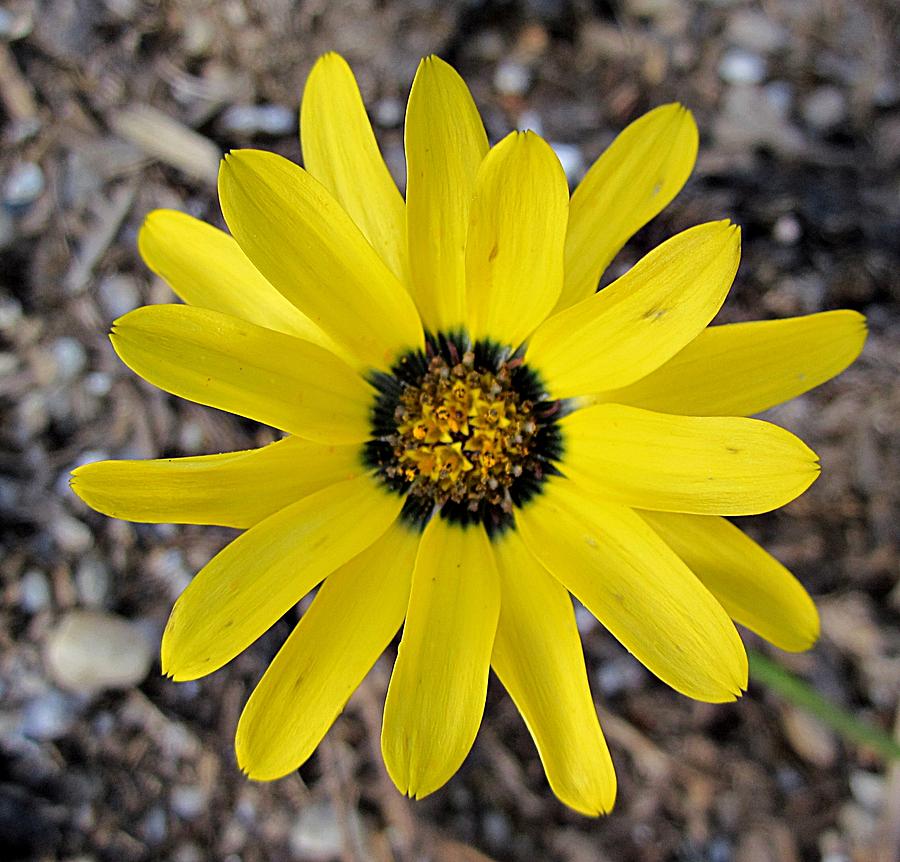African daisies, also known as cape marigold, are annual flowering plants native to the arid regions of southern Africa. They are grown most commonly as ornamental garden plants and produce numerous showy, colorful blooms in early summer through fall. The large flowers close at night and during bad weather but shine in full sun. Flower colors include white, yellow, orange, red, pink and violet. The African daisy is very easy to grow and requires very little maintenance after planting.
Osteospermum () also known as Veldt Daisies, African daisy or Cape Daisy is a bushy evergreen perennial. It is part of the Asteraceae family and is native to South Africa. It is a low growing spreading shrub that forms a mounding habit. Osteospermum has irregular toothed green foliage and daisy-like flowers. The flowering period begins usually in early Spring and will go until Autumn if some pruning and fertilising occurs and the weather doesn't get too hot during Summer. These flowers come in a huge assortment of colours and flower styles.
The most common colours are shades of pink, purples, yellows, creams, and oranges. Most flowers have a deep violet center however newer hybrids now come with a deep yellow center. Osteospermum prefer a full sun position in the garden and although not picky on the soil type they do require free draining soil. Once established these plants are drought tolerant and very tough and will tolerate dry soils.
Daisies are a type of flowering plant that belong to one of the largest plant families in the world. The most common type of daisy flowers that most people recognize are the ones with white petals and a yellow center. It is easy to identify most flowers in the daisy family due to their star-shape and elegant petals. Although some daisy species are invasive and regarded as weeds, many species have beautiful bright flowers to add color to any garden. But in Sydney, African daisies have proven to be just as tough and easy to grow as they are in their homeland.
Come winter, they reveal a showy, generous mass of flowers that close in low light. Petals come in a range of shades, from white, creamy yellow and orange, to bold pink, purple and red. If you can't decide on one colour, the 'Passion Mix' variety features pink, mauve and white in one plant. African daisy stems and leaves are coated in matted, downy hairs, giving them silvery-green colour. Low and fast-growing, the African daisy makes great ground cover and looks equally great in a pot.
The daisy-like composite flower consists of disc florets and ray florets, growing singly at the end of branches or sometimes in inflorescences of terminal corymbose cymes. The disc florets are pseudo-bisexual and come in several colors such as blue, yellow and purple. The hardy types usually show a dark blue center in the disc until the yellow pollen is shed.
The ray florets are female and are found diverse colors such as white, cream, pink, purple, mauve to yellow. Some cultivars have "spooned" petals such as "Pink Whirls". Many species flower a second time late summer, stimulated by the cooler night temperatures. Hardy types show profuse flowering in the spring, but they do not get a second flush of flowers. Fun series of compact arctotis is easy to control and finish in small pots for strong early-season sales. In three stunning colors, Opera makes a great complement to osteospermum and argyranthemum programs.
Brightly colored, daisy-like blooms are held above a compact rosette of silvery green foliage. Early-flowering, tough annuals are ideal for the landscape and small containers. Frost-tender, shrubby perennials often used as annuals, these showy hybrids result from crosses between several South African members of Arctotis. They bear large colorful daisies with contrasting dark halos on calf-high, leafless stems. The solitary blooms may be pink, red, orange, white, or yellow. They appear from summer into fall above densely massed, silvery green, slightly fuzzy leaves with deeply lobed margins.
Blooms tend to stay open wider and longer in cloudy conditions than do those of other arctotis. The name African daisy can refer to any of several plants from southern Africa, and identities are often confused, even by many seed companies and nurseries. Arctotis species have lobed leaves that are rough, hairy, or woolly; their blossoms usually sport a contrasting ring of color around a central eye. Dimorphotheca species have smooth green foliage; their ringless flowers either are white or fall into the yellow-salmon-orange range.
Woody, shrubby, white, yellow, or purple African daisies and the trailing types used as ground cover belong to the genus Osteospermum. Osteospermum 'Orange Symphony' is a trailing, evergreen, tender perennial with a profusion of bright tangerine-orange daisy flowers adorned with a deep purple eye. In cool summer climates, these beautiful flowers will produce a long-lasting display from spring to frost. The blossoms are borne on upright stems clad with lanceolate green leaves.
Great for sunny borders and containers where the luminous blooms will bring a cheerful splash of color. With yellow and white or purple flowers which are rich in pollen, this plant is known to attract bees. The underside of the white petals is tinged with blue, while the foliage is green. This perennial grows best in an area sheltered from the wind. It is not frost-tolerant, so in colder regions, it will need to be kept in a portable pot and be overwintered inside, or alternatively, you can treat it as an annual. The flowers bloom for most of the summer, in July and August.
It can grow quite large, up to around four feet in height and three feet in width. Theses daisies have star-shaped flower that has a large yellow disk in the center. One of the reasons why these daisies are so popular is due to the large number of flowers on the plant. This bushy type of daisy plant has flowers with beautiful colors such as pink, red, purple, and white – perfect plant in your summer garden. One of the most popular types of daisies is Shasta daisies .
This perennial bushy daisy produces flowers that have white petals and yellow center throughout the summer in your garden. They are also very easy to grow and just need to be in an area of your garden that gets full sun. This African-originated perennial groundcover is recognized for its large orange, yellow, pink or red flowers with dark centers surrounded by an orange ring.
It enjoys full sun, doesn't require much water and often blooms from spring to summer. Spreading low on the ground under 1 foot tall, arctotis acaulis can spread 2-3 feet, making it a great plant to cover large areas. This is a genus of daisies that encompasses over 60 species of flowering perennials. Daisies in this genus are native to dry regions of Southern Africa and are therefore more commonly known as African Daisies. They have typical daisy-shaped flowers, but exist in an array of colors, including orange, yellow, and brown.
These daisies are now naturalized in the United States, where many hybrid varieties have been cultivated with an even larger range of color options. Unusually, some species of African Daisies do not have stems, the flower appearing directly among the foliage on the base of the plant. Angelonia is also called summer snapdragon, and once you get a good look at it, you'll know why. It has flower spires that reach a foot or two high, but they're studded with fascinating snapdragon-like flowers with beautiful colorations in purple, white, or pink. It's the perfect plant for adding bright color to hot, sunny spaces, where it will bloom all summer long.
While all varieties are beautiful, keep an eye out for the sweetly scented selections. While most gardeners treat angelonia as an annual, it is perennial in Zones 9-10. Or, if you have a bright, sunny spot indoors, you can keep it flowering all winter. In mild, winter-rainfall areas they may be sown in late autumn or early winter (April–May). They can be sown directly in prepared beds, on a calm day when the wind will not blow the papery seeds away. For best results, prepare the beds with compost and remove clods and stones to make a fine bed.
Sow thickly and rake lightly to cover the seeds to prevent them being blown or washed away. Seedlings can be thinned or pricked out when they are about 5 cm tall. Young plants must also be kept moist until they reach the height of about 10 cm.
Seed is widely available in nurseries and supermarkets in South Africa. Selected forms of Namaqualand daisies are available for cultivation in a variety of shades, such as orange, cream, yellow and salmon. Osteospermum 'Bright Lights Double Moonglow' is one of the showiest flowers of all the African daisy varieties. This beautiful type of daisy has flowers consisting of creamy-yellow petals surrounding a bushy yellow center. This daisy cultivar grows in short clumps not more than 12" tall. Apart from its spectacular showy flowers, this perennial daisy blooms from late spring right up until the first frost.
This species is most commonly known as the Oxeye Daisy but is also sometimes referred to as Dog Daisy or Moon Daisy. It is a pretty grassland perennial, typically growing in meadows, pastures, and wasteland. At around 20 inches tall, the plant is of medium height, with single flowers sprouting from upright stems. Its toothed foliage is quite distinctive, with leaves being larger at the base of the plant, diminishing in size as they get closer to the top of the stem. The Oxeye Daisy prefers well-draining soil, but it will typically grow anywhere that is not soggy. This plant relies solely on seed to regenerate, though seeds can be successfully sown at any time of year.
The Oxeye Daisy grows quickly compared to other wildflowers, but it lacks staying power, usually dying off after two or three years. Are you thinking about adding daisies to your garden this spring? If so, you're in luck as daisies are some of the easiest flowers to grow. Commonly grown from seeds, daisies can be planted directly into your flowerbeds. Besides ample sunlight and a well-draining soil, daisies don't need much to thrive, making them one of the best low-maintenance flowers.
Daisies love the sun, making them one of the best full-sun flowers and aren't usually bothered by insects or disease. For best results, plant yours in a nutrient-rich, well-draining soil with seeds about 9 to 12 inches apart. This yellow and white daisy is the only annual type of daisy in the Bellis genus. English daisies are one of the easiest daisy species to recognize. They are perennial plants that have beautiful flowers with pure white petals fanning out from a yellow center.
These small white flowers are between 0.8" and 1.1" (2 – 3 cm) across, and a single flower grows on top of a leafless stem. 'Orange Symphony' Osteospermum displays cheery, bright orange daisy-like flowers with a violet-purple eye that bloom continuously from spring until fall. 'Orange Symphony' is a low maintenance plant that does not require deadheading for continuous bloom. New flowers will quickly cover old flowers to keep the plant looking its best. Please note that 'Orange Symphony' must have good drainage and does not like to have wet feet.
Be sure to let the soil in your containers get dry on top before watering and only plant in landscape beds with good drainage. A native of South Africa, it has naturalized throughout the southwestern United States. Blooms are 2-4 inches across in brilliant shades of white, yellow, and orange. An excellent variety to sow in early spring, as it will produce extravagant color for weeks.
Sow in early spring after the danger of frost has passed, seedlings are not winter hardy. In its native South Africa, the African daisy bursts into bloom when the spring rains come, although in gardens plants bloom copiously all summer. A tender perennial, it is grown most commonly as an annual. Like many of the plants in the daisy family from South Africa, it's tough enough to live in hot, dry conditions, but a modicum of moisture will bring out stellar blooms.
Daisy-like flowers 2 inches across, come in single, bi- or multicolors in shades of white, yellow, orange, red, coral, pink, blue, lavender, and purple. Oval or lance-shaped leaves are green or gray-green with smooth or toothed margins. Flowers close at night or on dark overcast days, though there are newer cultivars that remain open.
Townsendia daisies are a type of wild flowering plant that grows in high elevations. Depending on the species, these white and yellow flowering plants can be annuals or perennials. Some species have attractive flowers that grow on tall stems and produce ray florets. Other native species are small daily plants that have a spreading nature.
Echinacea 'Flame Thrower' flower has two-tone red and orange petals with a massive cone-shaped center that is brown red. This tall daisy plant adds beautiful orange flowers and fall colors to your garden. Echinacea flowers are a member of the daisy family in the tribe Heliantheae.
These species of daisies are easy to grow and will tolerate most conditions in your garden. To get the best out of the purple daisy flowers, plant them in mass to provide plenty of fall colors for your garden. Also known as blue-eyed daisy, this plant is a rare daisy type originated from South African.
As the name suggests, it has a stunning bluish dark center highlighted by an yellow outer string and white petals. The grandis Arctotis can cover three inches or more with bloom growing up to 2″. Echinacea 'White Swan' has the flower features of a typical Echinacea plant and the colors of a traditional daisy. The flowers have a yellow cone-like center protruding from a ray of short white petals surrounding it.
These are very hardy perennials that will attract pollinating insects late in the season. One of the most beautiful chrysanthemum daisies is the 'Robinson's Red' cultivar. This spectacular daisy has deep pink or magenta petals with contrasting bright yellow disk center. This plant from the daisy family also has fern-like foliage that adds color and volume to cut flower arrangements. Another popular variety of daisy in the genus Tanacetum is the 'golden feverfew daisy' (Tanacetum parthenium 'Aureum').
























